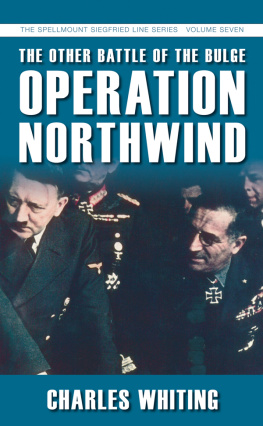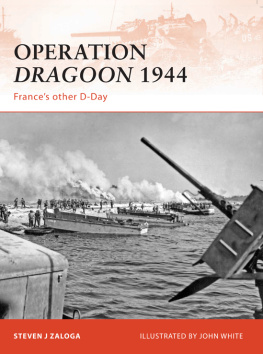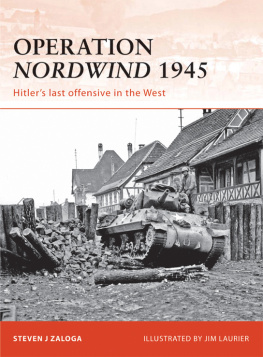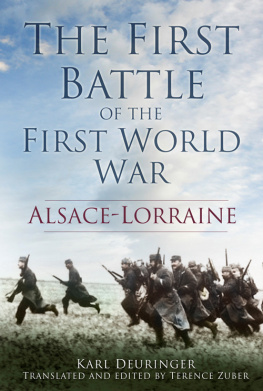The Other Battle of the Bulge Operation Northwind
Titles in the Spellmount Siegfried Line Series
Vol. 1 West Wall: The Battle for Hitlers Siegfried Line
The story of Hitlers top secret line of fortifications which turned out to be Germanys last line of defence in the final year of World War II
Vol. 2 44: In Combat from Normandy to the Ardennes
Eyewitness accounts of the attack from the beachhead to the Wall
Vol. 3 Bloody Aachen
The first major battle for the most impregnable part of the West Wall
Vol. 4 The Battle of Hurtgen Forest
The officially covered-up defeat of 12 US Divisions; the lead up to the Battle of the Bulge
Vol. 5 Ardennes: The Secret War
The secret preparations for the surprise attack in the Ardennes the USs Gettysburg of the 20th century
Vol. 6 Decision at St Vith
The decisive battle for the West Wall frontier town that broke the back of the German assault
Vol. 8 Pattons Last Battle
Pattons major breakthrough in the West Wall, before his fall from grace and his accidental death
Vol. 9 Bounce the Rhine
The British role in breaching the West Wall, and the triumphant crossing of the Rhine
Vol. 10 Paths of Death & Glory: The Last Days of the Third Reich
The battle for Europe, JanuaryMay 1945
THE OTHER BATTLE OF THE BULGE
OPERATION NORTHWIND
by
Charles Whiting

This paperback edition published in Great Britain in 2007 by
Spellmount an imprint of The History Press
The Mill, Brimscombe Port
Stroud, Gloucestershire, GL5 2QG
www.thehistorypress.co.uk
This ebook edition first published in 2016
All rights reserved
Charles Whiting 1986, 1990, 2002, 2007
The right of Charles Whiting to be identified as the author of this work has been asserted by him in accordance with the Copyright, Designs and Patents Act 1988
This ebook is copyright material and must not be copied, reproduced, transferred, distributed, leased, licensed or publicly performed or used in any way except as specifically permitted in writing by the publishers, as allowed under the terms and conditions under which it was purchased or as strictly permitted by applicable copyright law. Any unauthorised distribution or use of this text may be a direct infringement of the authors and publishers rights, and those responsible may be liable in law accordingly.
EPUB ISBN 978 0 7509 8014 2
Typesetting and origination by NPI Media Group
eBook converted by Geethik Technologies
CONTENTS
DEDICATION
Above all, I should like to thank the men who were there that terrible winter, Mr Hy Schorr and Mr Tom Dickinson of New York City. Without their help Operation Northwind could not have been written. I should also like to dedicate this book to those young men of the 3rd, 28th, 36th, 42nd, 44th, 45th, 63rd, 70th, 75th, 79th, 100th, and 103rd Infantry Divisions, the 101st Airborne Division and their comrades of the 12th and 14th Armored Divisions. Sixty odd years ago now, they sailed away from the shores of the United States, full of youthful energy and confidence, to liberate France. To those many thousand who never returned, this book is humbly dedicated.
Charles Whiting
The map entitled The Battle of Alsace is reproduced from Forrest C Pogues The Supreme Command, U.S. Army in World War II, (Washington, D.C.: Government Printing Office, 1954), courtesy U.S. Army Center of Military History.
Photographs are reprinted courtesy of the U.S. National Archives and General Research Division, the New York Public Library, Astor, Lenox and Tilden Foundations.
Maps

INTRODUCTION
The Battle of the Bulge, the German surprise attack on the American lines in the Belgian Ardennes in December, 1944, is celebrated in American military history as the major battle fought by the US Army in Europe in the Second World War.
Books on the subject, fiction and non-fiction, would fill a small library. It has been depicted in half a dozen films and a score of TV documentaries. Not many years ago the Battle of the Bulge was again world news, due to President Reagans controversial visit to Bitburg cemetery, Germany, where some of the SS who murdered US prisoners near Malmedy during the battle supposedly lie buried. Every high school kid can quote General MacAuliffes scornful reply to the German offer to surrender when his division was surrounded by them at Bastogne, Nuts. Actually he snorted something much cruder. Fortunately for the legend, his PR man censored the expletive in time. It could hardly have appeared in a school history book.
But who knows that the man who commanded the battered bastards of Bastogne during that celebrated siege went on to command another division in a second Battle of the Bulge? Who knows, too, that nearly a thousand of those airborne troopers who had survived the fight at Bastogne were either killed or wounded in that second battle, without benefit of publicity or the media coverage their earlier stand had gained them? The history of that second Battle of the Bulge in the winter of 1944/45 has never been recorded, in spite of the fact that it lasted a month longer than the original Battle of the Bulge and cost the Americans some 16,000 casualties. It also cost perhaps twice that number of French soldiers serving under American command.
Yet, strategically and politically, it was a much more significant battle than the original Battle of the Bulge. It can be argued that if the Germans second attack had succeeded, the whole Western military alliance might have broken up and France been plunged into political anarchy. Indeed, although the German plan did not succeed, the bitter memories of that second Battle of the Bulge had a long-term influence on Franco-American relations: one which, in the end, probably led to General de Gaulles decision to leave NATO and ensure that the defence of France lay solely in the hands of Frenchmen.
As we shall see, that unknown battle also first brought the United States Army indirectly into contact with an area and a problem which three decades later would escalate into Americas most significant military defeat of the second half of the twentieth century Vietnam.
What was this unknown battle? It was a German attack which the American command, thanks to Ultra, knew was coming. Yet it was one, too, which dealt them a stunning blow and forced the Supreme Commander, General Eisenhower, to order the first and only retreat of an American army in the whole course of the campaign in Western Europe. The Fhrer himself had given the attack its code-name Unternehmen Nordwind a bold assault on the apparently unsuspecting US Seventh Army dug in in the French border province of Alsace-Lorraine, just below the embattled Belgian Ardennes.
While the Americans were fully occupied in the north, warding off the attack in the Bulge, thinning their lines out to allow Pattons Third Army to counterattack, this new offensive would completely surprise the Americans in France, recapture Alsace-Lorraine and, with a bit of luck, knock France out of the war.
Thus it was, as the quarter of a million GIs of General Alexander Patchs relatively green US Seventh Army prepared to celebrate the last New Years Eve of the Second World War, eight German divisions, three of them SS, readied themselves in the snow-bound French hills for the surprise assault. At eleven-thirty precisely on the night of 31 December, 1944, that great wind would sweep down upon the
Next page











